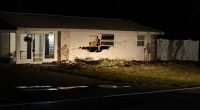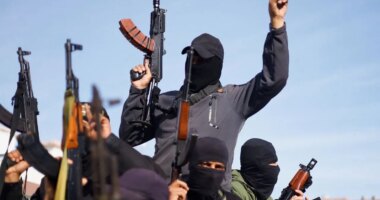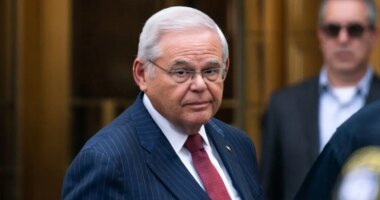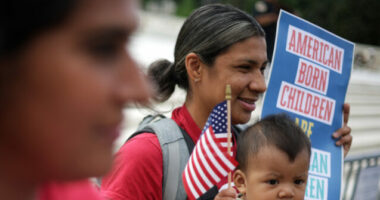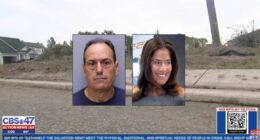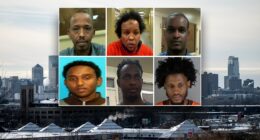Share this @internewscast.com
A BRUTAL police crackdown is underway in Brazil’s notorious Crackland – the sprawling district dubbed the world’s largest open-air drug den.
Once a constant presence, crowds of crack cocaine users have disappeared almost overnight after a decisive action by São Paulo authorities to permanently shut down the area.
In total, more than 500 officers took part in a major late-May raid targeting the drug-infested zone officially known as Cracolândia.
Guided by Governor Tarcisio de Freitas and Mayor Ricardo Nunes, the recent initiative has seen military police intensify stop-and-search patrols, close hostels frequented by users, conduct raids on dumpsters where dealers congregate, and commence the demolition of a nearby shantytown suspected of housing drug suppliers.
Residents say the change has been immediate — and striking.
“I walked around for 10 minutes finding no trace of them,” bar owner Marcelo Colaicovo told AP after passing through the area on a recent May afternoon.
“Even the stench was gone.”
Zombified streets
For years, Crackland has been a symbol of Brazil’s drug crisis.
A grim city-within-a-city, its addict residents openly smoke crack in broad daylight, sometimes just metres away from college campuses and the city’s main train station.
By day, the streets were lined with men and women wrapped in filthy blankets.
Some were as young as 13. Others were former professionals who fell into addiction.
Many scavenged through bins for recyclables, trying to make a few coins to buy their next rock.
Police long patrolled the edges of the zone, not to stop the drug use, but to try and contain the violence and robbery it often sparked.
Addicts and traffickers moved freely between broken shacks, makeshift camps and budget hostels used as crack houses.
A single hit could cost as little as a few cents, making crack dangerously accessible.
Photos from the latest crackdown reveal a changed – but still unsettling – picture.
In one image, an addict hunches over a crack pipe, flames flickering in the afternoon light.
In another, a homeless man lies sprawled across a pavement, unmobing.
Uniformed officers stand watch nearby, frisking users and checking ID documents.
Health workers in fluorescent vests approach addicts with clipboards, trying to offer help and an escape from the drug hell.
Municipal crews in gloves and masks dismantle shanty homes at Princesa Isabel square, long seen as the epicentre of the crisis.
The current clampdown also includes targeting the supply chain – a new tactic that sees police dismantling makeshift camps believed to house drug dealers just outside the main Crackland zone.
Cycle of failure
But critics warn the operation could follow the same failed pattern as previous efforts: a short-lived clean-up, followed by a slow return of users.
In 2017, then-Mayor João Doria sent in 900 police officers with tear gas, rubber bullets and stun grenades to break up Crackland.
He declared it over — only for the “fluxo”, the local term for the mass of addicts and dealers, to re-form a few blocks away within months.
Felipa Drumont, a trans woman who has lived on the streets of Crackland, told The Guardian at the time: “The police turned up throwing bombs at everyone. You don’t eat. You don’t sleep. Any money you can get goes on crack.”
Francisco Inácio Bastos, a leading drug expert who conducted Brazil’s national crack survey, said: “What we see is a change of project every administration, without any continuation.
“It’s all political. Without long-term planning, [Cracolândia] will continue as it is.”
A national emergency
Brazil has the highest number of crack cocaine users in the world — an estimated 370,000 in major cities.
São Paulo’s location at the heart of the country’s economy, and close to cocaine-producing neighbours Colombia, Peru and Bolivia, has made it a key trafficking hub for decades.
Crackland reflects the deep ties between poverty, inequality and addiction in Brazil.
The state has tried social programmes, like 2014’s “Open Arms” initiative — backed by Prince Harry during a visit — which offered shelter and cash for small jobs in exchange for treatment.
But the scheme was scrapped after criticism and lack of funding.
Since then, “mini-Cracklands” have emerged on the city’s outskirts, with users scattering across multiple zones after each police operation — rather than disappearing.
Still in the spotlight
Crackland is not hidden. It sits in one of São Paulo’s busiest districts, just blocks from concert halls, shopping centres, and the offices of South America’s biggest newspaper.
Office workers and college students rush past addicts lighting up in the street.
The contrast has made the area a constant source of embarrassment for city officials — and a visible sign of failed drug policy.
Despite the visible clean-up, few believe this latest effort will succeed where others failed.
Without major investment in long-term treatment, housing, and employment programmes, experts warn the crackdown will only scatter the problem — not solve it.
For now, São Paulo’s most infamous junkie town lies quiet. But history suggests it won’t stay that way for long.

